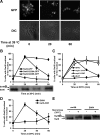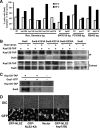Yeast Mpk1 cell wall integrity mitogen-activated protein kinase regulates nucleocytoplasmic shuttling of the Swi6 transcriptional regulator
- PMID: 20219973
- PMCID: PMC2861618
- DOI: 10.1091/mbc.e09-11-0923
Yeast Mpk1 cell wall integrity mitogen-activated protein kinase regulates nucleocytoplasmic shuttling of the Swi6 transcriptional regulator
Abstract
The yeast SBF transcription factor is a heterodimer comprised of Swi4 and Swi6 that has a well defined role in cell cycle-specific transcription. SBF serves a second function in the transcriptional response to cell wall stress in which activated Mpk1 mitogen-activated protein kinase of the cell wall integrity signaling pathway forms a complex with Swi4, the DNA binding subunit of SBF, conferring upon Swi4 the ability to bind DNA and activate transcription of FKS2. Although Mpk1-Swi4 complex formation and transcriptional activation of FKS2 does not require Mpk1 catalytic activity, Swi6 is phosphorylated by Mpk1 and must be present in the Mpk1-Swi4 complex for transcriptional activation of FKS2. Here, we find that Mpk1 regulates Swi6 nucleocytoplasmic shuttling in a biphasic manner. First, formation of the Mpk1-Swi4 complex recruits Swi6 to the nucleus for transcriptional activation. Second, Mpk1 negatively regulates Swi6 by phosphorylation on Ser238, which inhibits nuclear entry. Ser238 neighbors a nuclear localization signal (NLS) whose function is blocked by phosphorylation at Ser238 in a manner similar to the regulation by Cdc28 of another Swi6 NLS, revealing a mechanism for the integration of multiple signals to a single endpoint. Finally, the Kap120 beta-importin binds the Mpk1-regulated Swi6 NLS but not the Cdc28-regulated NLS.
Figures





Similar articles
-
Yeast Mpk1 mitogen-activated protein kinase activates transcription through Swi4/Swi6 by a noncatalytic mechanism that requires upstream signal.Mol Cell Biol. 2008 Apr;28(8):2579-89. doi: 10.1128/MCB.01795-07. Epub 2008 Feb 11. Mol Cell Biol. 2008. PMID: 18268013 Free PMC article.
-
Mechanism of Mpk1 mitogen-activated protein kinase binding to the Swi4 transcription factor and its regulation by a novel caffeine-induced phosphorylation.Mol Cell Biol. 2009 Dec;29(24):6449-61. doi: 10.1128/MCB.00794-09. Epub 2009 Oct 5. Mol Cell Biol. 2009. PMID: 19805511 Free PMC article.
-
Transcriptional reporters for genes activated by cell wall stress through a non-catalytic mechanism involving Mpk1 and SBF.Yeast. 2010 Aug;27(8):541-8. doi: 10.1002/yea.1782. Yeast. 2010. PMID: 20641022 Free PMC article.
-
Control of Gene Expression via the Yeast CWI Pathway.Int J Mol Sci. 2022 Feb 4;23(3):1791. doi: 10.3390/ijms23031791. Int J Mol Sci. 2022. PMID: 35163713 Free PMC article. Review.
-
SWI6 is a regulatory subunit of two different cell cycle START-dependent transcription factors in Saccharomyces cerevisiae.J Cell Sci Suppl. 1992;16:87-96. doi: 10.1242/jcs.1992.supplement_16.11. J Cell Sci Suppl. 1992. PMID: 1297653 Review.
Cited by
-
The Mechanism of Transcription Factor Swi6 in Regulating Growth and Pathogenicity of Ceratocystis fimbriata: Insights from Non-Targeted Metabolomics.Microorganisms. 2023 Oct 30;11(11):2666. doi: 10.3390/microorganisms11112666. Microorganisms. 2023. PMID: 38004677 Free PMC article.
-
The interplay between cell wall integrity and cell cycle progression in plants.Plant Mol Biol. 2023 Dec;113(6):367-382. doi: 10.1007/s11103-023-01394-w. Epub 2023 Dec 13. Plant Mol Biol. 2023. PMID: 38091166 Free PMC article. Review.
-
Elongating under Stress.Genet Res Int. 2011;2011:326286. doi: 10.4061/2011/326286. Epub 2011 Sep 7. Genet Res Int. 2011. PMID: 22567351 Free PMC article.
-
Host-derived reactive oxygen species trigger activation of the Candida albicans transcription regulator Rtg1/3.PLoS Pathog. 2023 Sep 28;19(9):e1011692. doi: 10.1371/journal.ppat.1011692. eCollection 2023 Sep. PLoS Pathog. 2023. PMID: 37769015 Free PMC article.
-
Activation of CWI pathway through high hydrostatic pressure, enhancing glycerol efflux via the aquaglyceroporin Fps1 in Saccharomyces cerevisiae.Mol Biol Cell. 2023 Aug 1;34(9):ar92. doi: 10.1091/mbc.E23-03-0086. Epub 2023 Jun 28. Mol Biol Cell. 2023. PMID: 37379203 Free PMC article.
References
-
- Abe J., Kusuhara M., Ulevitch R. J., Berk B. C., Lee J. D. Big mitogen-activated protein kinase 1 (BMK1) is a redox-sensitive kinase. J. Biol. Chem. 1996;271:16586–16590. - PubMed
-
- Bao M. Z., Schwartz M. A., Cantin G. T., Yates J. R., 3rd, Madhani H. D. Pheromone-dependent destruction of the Tec1 transcription factor is required for MAP kinase signaling specificity in yeast. Cell. 2004;119:991–1000. - PubMed
Publication types
MeSH terms
Substances
Grants and funding
LinkOut - more resources
Full Text Sources
Molecular Biology Databases

